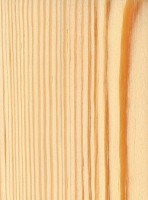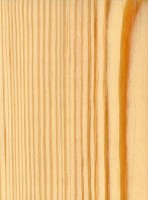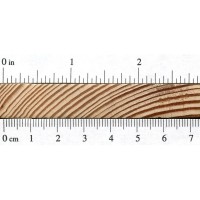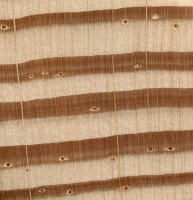 |
Common Name(s): Longleaf Pine Scientific Name: Pinus palustris Distribution: Southeastern United States, though also widely grown on plantations Tree Size: 100-115 ft (30-35 m) tall, 2-3 ft (.6-1 m) trunk diameter Average Dried Weight: 41 lbs/ft3 (650 kg/m3) Specific Gravity (Basic, 12% MC): .54, .65 Janka Hardness: 870 lbf (4,120 N) Modulus of Rupture: 14,500 lbf/in2 (100.0 MPa) Elastic Modulus: 1,980,000 lbf/in2 (13.70 GPa) Crushing Strength: 8,470 lbf/in2 (58.4 MPa) Shrinkage:Radial: 5.1%, Tangential: 7.5%, Volumetric: 12.2%, T/R Ratio: 1.5 |
Color/Appearance: Heartwood is reddish brown, sapwood is yellowish white.
Grain/Texture: Straight grained with a fine to medium texture.
Endgrain: Large resin canals, numerous and evenly distributed, mostly solitary ; earlywood to latewood transition abrupt, color contrast high; tracheid diameter medium-large.
Rot Resistance: The heartwood is rated as moderately resistant to decay.
Workability: Overall, Longleaf Pine works fairly well with most tools, though the resin can gum up tools and clog sandpaper. Longleaf Pine glues and finishes well.
Odor: Has a distinct smell that is shared among most species in the Pinus genus.
Allergies/Toxicity: Working with pine has been reported to cause allergic skin reactions and/or asthma-like symptoms in some people. See the articles Wood Allergies and Toxicity and Wood Dust Safety for more information.
Pricing/Availability: Should be widely available as construction lumber for a modest price.
Sustainability: This wood species is not listed in the CITES Appendices, but is on the IUCN Red List. It is listed as vulnerable due to a population reduction of over 20% in the past three generations, caused by a decline in its natural range, and exploitation. Natural occurrences of Longleaf Pine have been replaced by plantations of Loblolly and Slash Pine.
Common Uses: Longleaf Pine is commonly used for construction, such as: stringers, roof trusses, poles, joists, piles; as well as interior applications such as subflooring and sheathing. In exterior applications, it is usually pressure-treated with preservatives.
Comments: Longleaf Pine is considered to be in the group of southern yellow pines, and shares many characteristics with other species of this group (Slash, Shortleaf, and Loblolly Pine) such as being: hard, dense, and possessing an excellent strength-to-weight ratio.
- Austrian Pine (Pinus nigra)
- Caribbean Pine (Pinus caribaea)
- Eastern White Pine (Pinus strobus)
- Jack Pine (Pinus banksiana)
- Jeffrey Pine (Pinus jeffreyi)
- Khasi Pine (Pinus kesiya)
- Limber Pine (Pinus flexilis)
- Loblolly Pine (Pinus taeda)
- Lodgepole Pine (Pinus contorta)
- Maritime Pine (Pinus pinaster)
- Ocote Pine (Pinus oocarpa)
- Patula Pine (Pinus patula)
- Pinyon Pine (Pinus edulis)
- Pitch Pine (Pinus rigida)
- Pond Pine (Pinus serotina)
- Ponderosa Pine (Pinus ponderosa)
- Radiata Pine (Pinus radiata)
- Red Pine (Pinus resinosa)
- Sand Pine (Pinus clausa)
- Scots Pine (Pinus sylvestris)
- Shortleaf Pine (Pinus echinata)
- Slash Pine (Pinus elliottii)
- Spruce Pine (Pinus glabra)
- Sugar Pine (Pinus lambertiana)
- Sumatran Pine (Pinus merkusii)
- Table Mountain Pine (Pinus pungens)
- Western White Pine (Pinus monticola)
- Virginia Pine (Pinus virginiana)








I was in North Carolina not too long ago and noticed that long leaf pine trees grow tall and straight with few branches along the trunk. I wondered why they weren’t more widely used as lumber. Now I understand that they were highly desirable as lumber and then of course, deforested.
They don’t grow fast enough for today’s lumber industry.
Longleaf pine is superior to the other southern yellow pines in strength, hardness and rot resistance. It has been used for keels of ships destined for tropical waters, where it was judged superior to white oak in resistance to marine borers. The underwater caissons for building the foundations of the Brooklyn bridge were built of longleaf pine. They are still down there. Salvaged longleaf pine heartwood is in strong demand as premium flooring. Salvaged wood is also great for solidbody guitars. Unfortunately there isn’t much if any new lumber available. The old virgin stands were mostly cut by the 1920’s,… Read more »
Is this species considered low in population/endangered?
Can you tell me what kind of wood this is? It is a beam out of a 100 year old building.